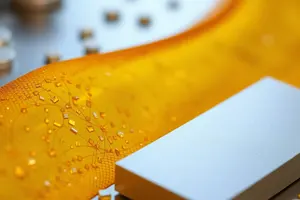Podcast
Questions and Answers
What is the PRIMARY focus of material science?
What is the PRIMARY focus of material science?
- Exploring the relationships between the structures and properties of materials. (correct)
- Designing new structures for buildings and bridges.
- Improving the performance of electronic components through material selection.
- Creating predetermined sets of properties in new materials
Which aspect of a material does material engineering PRIMARILY focus on?
Which aspect of a material does material engineering PRIMARILY focus on?
- Predicting future material costs and availability.
- Designing the structure of materials to achieve specific desired properties. (correct)
- Studying the environmental impact of different materials.
- Analyzing existing materials to understand their atomic structure.
Why is it important to study Material Science and Engineering (MSE)?
Why is it important to study Material Science and Engineering (MSE)?
- To strictly adhere to traditional manufacturing processes.
- To exclusively focus on improving the aesthetic appeal of consumer products.
- To understand and manipulate material properties for various applications. (correct)
- To limit the use of new materials in engineering applications.
Considering the disaster involving the Hindenburg airship, what material property contributed most significantly to its susceptibility to ignition?
Considering the disaster involving the Hindenburg airship, what material property contributed most significantly to its susceptibility to ignition?
In the context of a lithium-ion battery failure, what role does the separator play, and what property is most crucial for its proper function?
In the context of a lithium-ion battery failure, what role does the separator play, and what property is most crucial for its proper function?
When categorizing components of MSE, what is 'characterization' primarily concerned with?
When categorizing components of MSE, what is 'characterization' primarily concerned with?
Considering the components of MSE, how does 'processing' contribute to the properties of a material?
Considering the components of MSE, how does 'processing' contribute to the properties of a material?
Considering the properties of materials, which of the following BEST describes 'thermal' properties?
Considering the properties of materials, which of the following BEST describes 'thermal' properties?
Which of these materials is MOST likely to be classified as a ceramic?
Which of these materials is MOST likely to be classified as a ceramic?
Why are metal alloys often preferred over pure metals in engineering applications?
Why are metal alloys often preferred over pure metals in engineering applications?
What is a defining characteristic of polymers compared to metals or ceramics?
What is a defining characteristic of polymers compared to metals or ceramics?
What is the primary advantage of using composite materials in engineering design?
What is the primary advantage of using composite materials in engineering design?
What is a KEY characteristic of semiconductors that differentiate them from conductors and insulators?
What is a KEY characteristic of semiconductors that differentiate them from conductors and insulators?
What critical requirement must be met by biomaterials used in medical implants?
What critical requirement must be met by biomaterials used in medical implants?
What is the defining characteristic of 'smart materials'?
What is the defining characteristic of 'smart materials'?
What is the defining feature of nanomaterials?
What is the defining feature of nanomaterials?
What is the PRIMARY reason for the Titanic's sinking, according to the introductory information?
What is the PRIMARY reason for the Titanic's sinking, according to the introductory information?
Electrical properties are shown to be directly affected by...
Electrical properties are shown to be directly affected by...
The performance of a material is defined by:
The performance of a material is defined by:
Which of these options is NOT a component of MSE mentioned?
Which of these options is NOT a component of MSE mentioned?
Flashcards
Material Science
Material Science
Involves the relationships between the structures and properties of materials.
Material Engineering
Material Engineering
Designing and engineering the structure of a material to produce a predetermined set of properties.
Structure (MSE)
Structure (MSE)
Levels of arrangement of a material's internal components.
Properties (MSE)
Properties (MSE)
Signup and view all the flashcards
Processing (MSE)
Processing (MSE)
Signup and view all the flashcards
Performance (MSE)
Performance (MSE)
Signup and view all the flashcards
Metals
Metals
Signup and view all the flashcards
Ceramics
Ceramics
Signup and view all the flashcards
Polymers
Polymers
Signup and view all the flashcards
Composites
Composites
Signup and view all the flashcards
Semiconductors
Semiconductors
Signup and view all the flashcards
Biomaterials
Biomaterials
Signup and view all the flashcards
Smart Materials
Smart Materials
Signup and view all the flashcards
Nanomaterials
Nanomaterials
Signup and view all the flashcards
Study Notes
- These are study notes for an introductory lecture on Material Science and Engineering.
Introduction
Titanicwas considered unsinkable due to its engineering.- The
Hindenburgairship used hydrogen for buoyancy. - The outer skin was made of cotton coated with iron oxide (Fe₂O₃) and aluminum powder making it highly susceptible to ignition.
- Samsung Galaxy Note 7 explosions were due to design flaws in the lithium-ion battery separator, which was too fragile.
Material Science
- Involves studying the relationships between the structures and properties of materials.
- Examines how the atomic and molecular structure affects electrical, thermal, & mechanical properties.
Material Engineering
- Involves designing and engineering the structure of a material to produce specific properties.
- Focuses on modifying, enhancing, or creating new materials for better performance in electronic components.
Components of Material Science and Engineering (MSE)
-
Structure refers to the arrangement of internal components at different levels.
-
Subatomic level involves electrons, protons, and neutrons.
-
Atomic level involves elements from the periodic table and their atomic structure.
-
Microscopic level involves groups of atoms bonded together.
-
Macroscopic level involves structures visible to the naked eye.
-
Property refers to a material trait in terms of its response to a specific stimulus.
-
Mechanical properties involve deformation under load or force.
-
Electrical properties include conductivity and dielectric constant.
-
Thermal properties include heat capacity.
-
Magnetic properties involve response to a magnetic field.
-
Optical properties involve response to electromagnetic waves/light.
-
Deteriorative properties involve chemical reactivity.
Example Materials
-
Silicon (Si):
-
Structure: Diamond cubic crystal, semiconductor with a 1.12 eV band gap.
-
Properties: High melting point (1414°C), brittle, excellent thermal and electrical conductivity.
-
Performance: Used in microchips, solar panels, optical fibers, and MEMS sensors.
-
Processing: Extracted from quartz, purified via the Czochralski process and doped for conductivity control.
-
Characterization: XRD (crystal structure), SEM (surface analysis), Four-Point Probe (resistivity), and Raman Spectroscopy (stress measurement).
-
Cotton (Natural Fiber):
-
Structure: Cellulose (C₆H₁₀O₅)n with crystalline and amorphous arrangement, forming a fibrous structure.
-
Properties: Soft, lightweight, breathable, high moisture absorption, biodegradable, but prone to wrinkling/shrinking.
-
Performance: Used in textiles, medical bandages, paper, and insulation (comfort, durability, biodegradability).
-
Processing: Harvested, cleaned, spun into yarn, woven into fabric, and chemically treated (bleaching, dyeing).
-
Characterization: SEM (fiber structure), FTIR (chemical composition), TGA (thermal stability), moisture absorption, and tensile testing.
Why Study Material Science and Engineering?
- Facilitates material selection for various applications.
- Enables the fabrication of new materials with enhanced properties.
- Aids in the investigation and understanding of material behavior.
Solid Materials
-
Metals:
-
Compounds containing one or more metallic elements.
-
Strong, stiff, ductile, resistant to fracture, and excellent conductors.
-
Examples: Metal Alloys.
-
Ceramics:
-
Compounds between metallic and nonmetallic elements.
-
Strong, stiff, hard, and insulative to heat and electricity but prone to fracture.
-
Examples: Clay and Porcelain.
-
Polymers:
-
Organic compounds based on nonmetallic elements.
-
Not stiff or strong, but ductile and pliable, allowing easy deformation.
-
Examples: Plastic and Rubber.
-
Composites:
-
Composed of two or more individual materials, combining the best characteristics of each.
-
Examples: Cement and Fiber Glass.
Advanced Materials
-
Semiconductors:
-
Electrical properties are between conductors and insulators.
-
Extremely sensitive to impurities.
-
Used in Integrated Circuits.
-
Biomaterials:
-
Implanted components that replace or repair damaged body parts.
-
Must be non-toxic and compatible with body tissues.
-
Used in Artificial Parts.
-
Smart Materials:
-
Intelligent materials that can sense changes in their environment.
-
Used in Sensors.
-
Nanomaterials:
-
Future technologies utilizing structural features on the nanometer scale.
Research Task
- Analyze different materials used for specific items to understand their properties and applications.
- Tempered Glass, Soda-Lime Glass, Aluminosilicate Glass, Sapphire Glass, Ion-Exchange Processed Glass
- Hybrid Glass-Polymer Composite
Studying That Suits You
Use AI to generate personalized quizzes and flashcards to suit your learning preferences.




